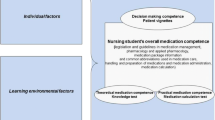Abstract
The aim of this study was to describe the basic mathematical proficiency and the medication calculation skills of graduating nursing students in Finland. A further concern was with how students experienced the teaching of medication calculation. We wanted to find out whether these experiences were associated with various background factors and the students' medication calculation skills.
In spring 1997 the population of graduating nursing students in Finland numbered around 1280; the figure for the whole year was 2640. A convenience sample of 204 students completed a questionnaire specially developed for this study. The instrument included structured questions, statements and a medication calculation test. The response rate was 88%. Data analysis was based on descriptive statistics.
The students found it hard to learn mathematics and medication calculation skills. Those who evaluated their mathematical and medication calculation skills as sufficient successfully solved the problems included in the questionnaire. It was felt that the introductory course on medication calculation was uninteresting and poorly organised. Overall the students' mathematical skills were inadequate. One-fifth of the students failed to pass the medication calculation test. A positive correlation was shown between the student's grade in mathematics (Sixth Form College) and her skills in medication calculation.
Similar content being viewed by others
References
Adams, A. & Duffield, C. (1991). The value of drills in developing and maintaining numeracy skills in an undergraduate nursing programme. Nurse Education Today 11(3): 213-219.
Ammattikorkeakoulu AMKOTA-tietokanta (1999). http://www.csc.fi./amkota/29.6.1999
Arndt, M. (1994). Nurses' medication errors. Journal of Advanced Nursing 19(3): 519-526.
Bath, J.B. & Blais, K. (1993). Learning style as a predictor of drug dosage calculation ability. Nurse Educator 18(1): 33-36.
Bayne, T. & Bindler, R. (1988). Medication calculation skills of registered nurses. The Journal of Continuing Education in Nursing 19(6): 258-262.
Bindler, R. & Bayne, T. (1991). Medication calculation ability of registered nurses. IMAGE: Journal of Nursing Scholarship 23(4): 221-224.
Black, R.L. (1992). Pharmacology instruction: A game approach for students. Nurse Educator 17(2): 7-8.
Blais, K. & Bath, J.B. (1992). Drug calculation errors of baccalaureate nursing students. Nurse Educator 17(1): 12-15.
Bliss-Holtz, J. (1994). Discriminating types of medication errors in nursing practice. Nursing Research 43(6): 373-375.
Bourque, L.B. & Clark, V.A. (1992). Processing Data: The Survey Example. California: Sage.
Burns, N. & Grove, S.K. (1993). The Practice of Nursing Research. Conduct, Critique and Utilization, 2nd edn. Philadelphia: W B Saunders Company.
Cartwright, M. (1996). Numeracy needs of the beginning registered nurse. Nurse Education Today 16(2): 137-143.
Cooper, M.C. (1995). Can zero defects philosophy be applied to drug errors. Journal of Advanced Nursing 21(3): 487-491.
Courtenay, M. (1991). A study of the teaching and learning of the biological sciences in nurse education. Journal of Advanced Nursing 16(9): 1110-1116.
Craig, G.P. & Sellers, S.C. (1995). The effects of dimensional analysis on the medication dosage calculation abilities of nursing students. Nurse Educator 20(3): 14-18.
Flynn, E.R., Wolf, Z.R., McGoldrick, T.B., Jablonski, R.A.S., Dean, L.M. & McKee, E.P. (1996). Effect of three teaching methods on a nursing staff's knowledge of medication error risk reduction strategies. Journal of Nursing Staff Development 12(1): 19-26.
Gee, P.R., Peterson, G.M., Martin, J.L.S. & Reeve, J.F. (1998). Development and evaluation of a computer-assisted instruction package in clinical pharmacology for nursing students. Computers in Nursing 16(1): 37-44.
Gladstone, J. (1995). Drug administration errors: A study into the factors underlying the occurrence and reporting of drug errors in a district general hospital. Journal of Advanced Nursing 22(4): 628-637.
Kapborg, I.D. (1995). An evaluation of Swedish nurse students' calculating ability in relation to their earlier educational background. Nurse Education Today 15(1): 69-74.
Leino-Kilpi, H. & Tuomaala, U. (1989). Research ethics and nursing science: An empirical example. Journal of Advanced Nursing 14(6): 451-458.
Litwin, M. (1995). How to Measure Survey Reliability and Validity. California: Sage.
Navarro, J.D.S., Alvarez, J.A.T., Casado, M.P.S. & Polo, M.P. (1993). A Dynamo application of microcomputer-based simulation in health sciences teaching. International Journal of Nursing Studies 30(5): 425-436.
Northrop, C.C. (1992). A domino pharmacology review game. Nurse Educator 17(5): 3.
Opetushallitus (1991). Sairaanhoitaja, kätilö ja terveydenhoitaja, opetussuunnitelman perusteet 1991. Opetushallituksen julkaisusarjat. Opetussuunnitelma 1/1991. Helsinki: Valtion painatuskeskus.
Opetushallitus (1996). Sosiaali-ja terveysala. Opistoaste. Ammatillisen koulutuksen opetussuunnitelman perusteet. Opetushallitus. Helsinki: Hakapaino Oy.
Pharmaca Fennica (1996). Rauma: Kirjapaino Oy West Point.
Segatore, M., Edge, D.S. & Miller, M. (1993). Posology errors by sophomore nursing students. Nursing Outlook 41(4): 160-165.
Shockley, J.S., McGurn,W.C., Gunning, C., Graveley, E. & Tillotson, D. (1989). Effects of calculator use on arithmetic and conceptual skills of nursing students. Journal of Nursing Education 28(9): 402-405.
Smith Bilancett, S. (1992). Pharmacology software programs. Nurse Educator 17(6): 5-10.
Solante, S. & Leino-Kilpi, H. (1998). Mitä koulutus tuotti? Viisi vuotta työelämässä olleiden hoitotyöntekijöiden näkemyksiä koulutuksen tuottamista valmiuksista. Hoitotiede 10(2): 89-96.
Veräjänkorva, O. & Leino-Kilpi, H. (1998). Lääkehoito ja sen opetus. Empiirinen tutkimus hoitoopin opettajien näkemyksistä valmiuksistaan ja toteutuneesta opetuksesta. Turun yliopisto. Hoitotieteen laitoksen julkaisuja. Tutkimuksia ja raportteja A:23/1998. English abstract. Turku.
Author information
Authors and Affiliations
Rights and permissions
About this article
Cite this article
Grandell-Niemi, H., Hupli, M. & Leino-Kilpi, H. Medication Calculation Skills of Graduating Nursing Students in Finland. Adv Health Sci Educ Theory Pract 6, 15–24 (2001). https://doi.org/10.1023/A:1009842501113
Issue Date:
DOI: https://doi.org/10.1023/A:1009842501113




